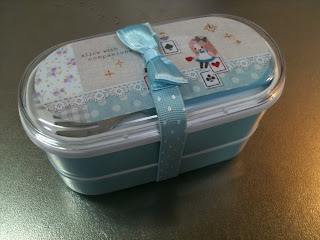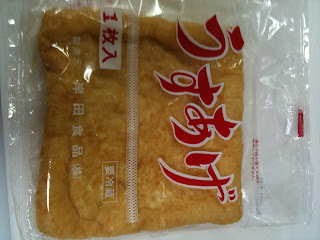What is in a Japanese bento? Well, it is a boxed lunch which usually consists of cold or room temperature rice and a variety of side dishes, also served cold or room temperature. In Japanese high schools, there is no school lunch to buy and no microwave to reheat leftovers (my go-to lunch when teaching in the States), so unless I planned on surviving on instant ramen, I would have to be creative and learn to make Japanese-style bento lunches.
My kawaii Alice in Wonderland bento box
The other thing to worry about is that it needs to be filling enough (since the Japanese workday is very long and teachers can’t have snacks during the day, unless it’s a gift from a coworker, but more on omiyage later), and fit into one of the smallish and adorable Japanese bento boxes. Oh, and it should be as visually appealing and kawaii (cute) as possible. There are plenty of places online to see the crazy levels that people go to make kawaii bentos, but, since I’m not artistically talented, I won’t be making any Hello Kitty potatoes or sushi rolls that look like Stitch – sorry.
Every once in a while, I’ll post a picture of a bento that I’ve bade, as well as recipes which are great bento fillers. They’re mostly a strange mix of Japanese and American, but they work for me. I hope my suggestions help with my fellow ALTs who have started bringing their own lunches.
---
Today's bento: Broad bean and tomato salad, steamed broccoli, and brown rice with pickled ginger
Broad Bean and Tomato Salad
Dry broad beans
1/2 onion, unchopped
2 bay leaves
2 cloves garlic, whole
1 2-inch piece of konbu* (optional)
Cherry tomatoes, quartered and seeded**
1 tbs salt
Balsamic vinaigrette dressing (see bellow), to taste
1. Rinse and sort the beans (it’s possible, though rare, that small rocks, sticks, and other non-edibles got through the sorting machines, so always give dry beans a quick check before cooking). Cover by at least 1-2 inches of water, and leave to soak in the fridge for up to 12 hours (I usually put the beans to soak before I leave for work).
2 bay leaves
2 cloves garlic, whole
1 2-inch piece of konbu* (optional)
Cherry tomatoes, quartered and seeded**
1 tbs salt
Balsamic vinaigrette dressing (see bellow), to taste
1. Rinse and sort the beans (it’s possible, though rare, that small rocks, sticks, and other non-edibles got through the sorting machines, so always give dry beans a quick check before cooking). Cover by at least 1-2 inches of water, and leave to soak in the fridge for up to 12 hours (I usually put the beans to soak before I leave for work).
2. Drain and rinse the beans and transfer them to a large pot. Cover with water and add the onion, bay leaves, garlic, and konbu (if using). DO NOT add salt at this time (it will cause the beans to get very soft and burst. Good for blackbean soup or chili; bad for bean salad). Bring to a simmer. When the beans are about 15 minutes from done (but still firm in the center), add the salt to the water. It’s hard to judge the time it takes to cook dry beans, but this batch of broad beans took a long time for me (about 1 1/2 hours). Most batches of soaked beans (especially smaller ones, like kidney or black beans), cook in an hour or less. Test the doneness by eating one or cutting it in half. Do not allow the beans to overcook or become too mushy. For this salad, you want them to keep their shape.
3. When the beans are tender but not falling apart, drain them and rinse under cold water for a minute to stop the cooking process. (At this point, you can remove some of the batch to use for other recipes during the week – I’ll update later with suggestions from what I’ve made with my cooked beans) Remove the onion, bay leaves, garlic, and konbu.
4. To make the salad, add the cooked and cooled beans to a bowl. Add the quartered and seeded tomatoes and balsamic vinaigrette (see bellow). This salad can be made a day ahead and served at room temperature.
* Quick note about konbu: Konbu is a type of dried seaweed that’s made in Hakkaido and is sold in thick sheets. There are ways to cook and eat it, but in it most frequently used as an ingredient in dashi, Japanese soup stock. It is also used as a flavoring agent in things like beans and rice, and as a way to add nutrients, like iodine and vitamin B12, to these foods. I often use it as a natural source of umami, the fifth basic taste (the savory flavor of things like meat, mushrooms, cheese, soy sauce, and tomatoes). Konbu has little taste on its own, but instead brings out the umami in other foods. In short, it just makes things taste better.
** Why seed the tomatoes? Leaving in the seeds and gel will make the salad far too watery (due to the salt in the dressing drawing out additional moisture) and will add too much acidity. You can skip this step, but the salad won’t be as good. Trust me.
I know it takes a long time to cook dry beans, but they last a while, so it's a great way to cook once on the weekend and have food ready for lunch throughout the week. Also, simmering beans doesn't need constant babysitting, so you can do something else while you cook (Last night, I was reading the news while cooking the beans, regularly checking to make sure they didn't boil over - obviously I don't suggest taking a nap or going for a jog, but you can do other things around the house while beans cook)
---
Basic Balsamic Vinaigrette
Balsamic vinegar
Dijon mustard
Honey
Extra virgin olive oil
Water (optional)
Dry herbs (parsley, basil, chive, oregano, marjoram, etc)
Salt and pepper
Dijon mustard
Honey
Extra virgin olive oil
Water (optional)
Dry herbs (parsley, basil, chive, oregano, marjoram, etc)
Salt and pepper
(Sorry, this dressing is done to taste, especially since I like my dressing very acidic and with a lot of mustard. The good thing is once you learn the basic technique, it’s easy to personalize.)
In a medium bowl, whisk together the mustard, vinegar, honey (start with just a little, since balsamic vinegar is already sweet), salt, pepper, and herbs. If you want a lower fat dressing, add some water now (to replace some of the olive oil). Once that is very well mixed (emulsified – the mustard and honey helps the water-based vinegar mix with the oil without separating, if done correctly), begin to SLOWLY pour in the oil as you continue to whisk (it helps to put a moist tea towel under the bowl to help it from sliding around). Once you get to the desired oil-acidic level of the dressing, it’s ready.
Make enough dressing to last a week or two, since it stays well in the fridge, and is so much more delicious than chemical mystery dressings from the store.




















